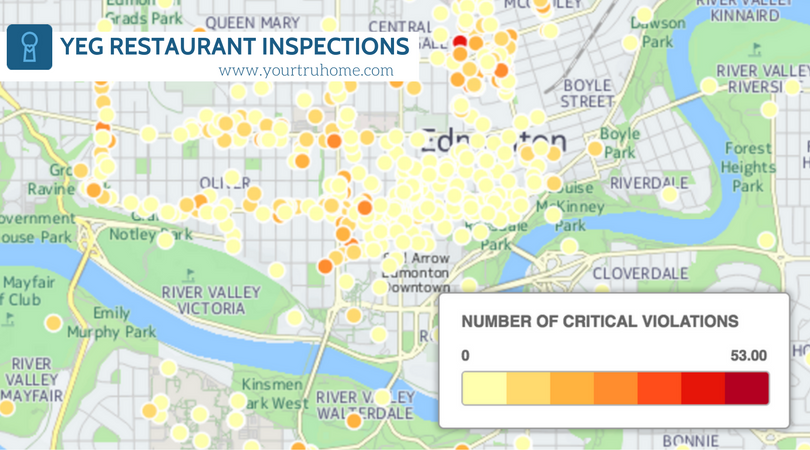Are You Concerned About Edmonton Restaurant Violations?
How many violations does an Edmonton restaurant need to receive for you to stop going there, or do you even care?
In our province, Alberta Health Services is in charge of monitoring and regulating restaurants to ensure they comply with the public health legislation and standards in Alberta.
While each restaurants violations are tracked online at www.restaurantinspections.ca, it is unlikely that you as a consumer are visiting this website prior to go out to eat each time. More than likely, you probably have never even visited it.
At present time, we often do not consider the risks involved with eating out and that these risks may be far greater at certain establishments then others. How risky is eating out? Are certain restaurants worse or better? Or more so, do I even want to know? Perhaps, ignorance is bliss…until one day, your kneeling over the toilet bowl experiencing a terrible case of food poisoning.
According to a recent poll by Open Data Edmonton, 43% of people do want better access to the Restaurant Inspection data. This indicates that access to this type of data is important to the public.
At TruHome, we are all about enhancing our clients (and the people of YEG) lifestyle through more open and transparent data. We also, just happen to be curious folks who ask a lot questions…..which is why we couldn’t wait to get our hands on the restaurant inspection data.
Through Alberta Health Services, restaurants may encounter 4 different types of inspections:
- Initial / Approval – an inspection performed before a restaurant opens or if there is a new owner to determine if the facility will be able to prepare food safely and complies with applicable legislation.
- Monitoring / Routine – an inspection performed without notice to ensure food is being handled safely and complies with applicable legislation. Restaurants usually have 1 to 3 monitoring inspections per year.
- Risk Management / Re-inspection – an inspection performed to ensure that unsafe practices and violations noted in previous inspections have been corrected.
- Demand / Complaint – an inspection performed to follow up on complaints from the public or another agency alleging an unsafe condition or violation.
In our Edmonton Restaurant Inspection visualization, we felt that critical violations would be the most important measure for #yegfoodies, as this really touches on public safety concerns. Through our visualization, we soon discovered that while some Edmonton restaurants had virtually no violations, others obtained over 53 in the last 3 years alone (2014-2016).
According to the AHS:
Monitoring inspections are conducted unannounced and are considered “complete” inspections, meaning the inspection involves Environmental Health Officers observing and documenting compliance under fifteen categories:
1. General Sanitation/Structure
2. Water Supply – Public or private supply
3. Sewage System – Public or private
4. Food Handling Practices
5. Cold Food Storage/Display
6. Hot Food Storage/Display
7. Staff Hygiene
8. Equipment and Utensils (Condition/Storage/Display)
9. Dishwashing Equipment
10. Washroom (Public & Staff)
11. Dry Goods Storage
12. Pest Infestation/Control
13. Safe Food Certification
14. Sanitation Procedures/Pest Control Record
15. Valid Food Handlers Permit
It makes us wonder, will the knowledge of the number of violations a restaurant has received impact your decision to eat there? Or more importantly, is there a better way that the province or the city of Edmonton can communicate a restaurants track record more openly to the publicly?
The city of Toronto has taken significant steps to making their inspections more transparent. The Toronto DineSafe program grades each restaurant through a colour coded system:
- Green for Pass
- Yellow for Conditional Pass
- Red for Closed
These grades are required to be visibly posted at each restaurant. Since, implementing this program, Toronto went from 78.2% of restaurants passing to 92.4% by the end of 2012. According to the Food Service Packaging Institute: “In 2010 DineSafe won the Samuel J. Crumbine Consumer Protection Award for providing outstanding food protection services – the first time an organization outside the United States has won this prestigious award.”
Based on this, it does show a direct correlation of how accessible data has improved the quality of the restaurant industry in Toronto.
Can Alberta restaurants improve and reduce the number of violations? How can, we as a province move forward and be recognized as a leader in this capacity?
At TruHome, we believe in opening up the data, but, more specifically on the how the data is communicated to the public. How do you think Restaurant Inspection data should be displayed (online or off)?


